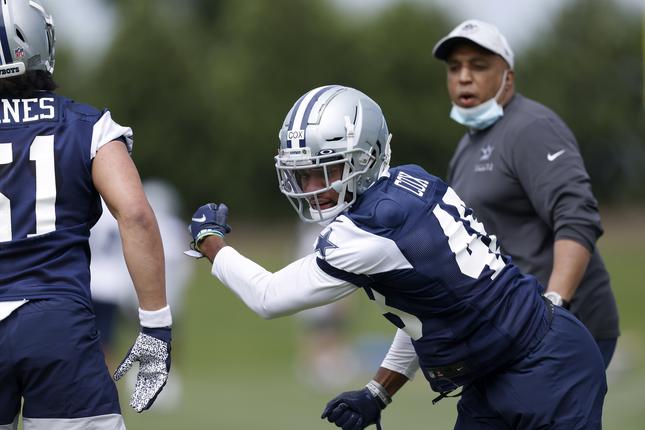Film room: Why Dallas Cowboys LB Jabril Cox will become a starter by 2023
As a part of a Dallas Cowboys draft class that included Micah Parsons, it’s easy to understand why rookie fourth-round pick Jabril Cox has been overshadowed a bit since arriving in Dallas.
Despite what Dak Prescott may fool you into believing, fourth-round picks usually don’t amount to much in the NFL. Pro Football Focus
released a data study in February
that revealed that fourth-round linebackers have about a 35% chance of becoming starting-caliber contributors at some point in their careers.
While those odds are long, I feel confident that Cox will beat those odds thanks to a progressive skill set that will have him starting by 2023.
Look around the NFL and you will see that the prevailing body type for linebackers has changed. The 6-foot-4, 250-pound downhill thumpers have given way to the 6-foot-2, 230-pound athletes who can make plays sideline-to-sideline and, most importantly, thrive in coverage.
That last point is why Cox will become a starter in the future, as the 6-foot-3 and 232-pound linebacker excels in coverage. As offenses have zeroed in on creating mismatches and taking advantage of the defense’s second-level defenders, players like Cox have become extremely valuable on Sundays in an effort to defend opposing offense’s aerial attacks.
In college, Cox’s film in pass coverage is some of the best I’ve seen at the linebacker in recent memory, as he even outperformed most safeties in the class against the pass.
Cox is excellent in zone coverage, as he does well relating to receivers entering his area while maintaining the proper spacing and reading the quarterback’s intentions.
Having said that, Cox really separates himself from the pack in man coverage. The ”good” coverage linebackers in college earn that reputation by providing tight man coverage against tight ends and running backs; however, Cox took it a step further, proving to be effective against bigger slot-receiver types. Cox’s 4.5 speed enables him to
carry vertical routes
or stay attached to
crossing routes

with incredible consistency.
It’s one thing to have the speed to run with a slot WR, but if you can’t anticipate and get in/out of breaks, then it doesn’t really matter, as offenses will just adjust their vertical routes to stop and deep comeback routes. This is where Cox truly separates himself from the pack, as he has the ability to anticipate and mirror breaks like a defensive back. Here’s an example:
On this play, Cox is matched up in one-on-one man coverage to the No. 1 WR in Florida’s trips left shotgun formation. When the ball is snapped, Cox is patient at the line of scrimmage, as he makes sure to not bite on the receiver’s hesitation move during his release. Then, Cox effortlessly slides into phase with the receiver once he pushes vertical with his route.
From there, Cox does an outstanding job reading the receiver’s hips, which tipped him off to when the receiver is going to make his break back toward the line of scrimmage on the deep comeback route. This allows Cox to easily mirror the break, providing the QB with zero room for a completion (if he wanted to throw that way).
Cox may have made that look easy, but believe me that it is anything but.
I know what you’re thinking, “But John, if he’s so good in coverage, why did he fall to the fourth round?”
While I wasn’t in an NFL draft room, I believe he fell to Day 3 for two main reasons: durability and run defense concerns.
In terms of durability, Cox has had a couple of nagging injuries pop up throughout his college career. In 2019, he played the last third of North Dakota State’s season with a torn labrum that required surgery in the offseason. He stayed healthy in 2020 after transferring to LSU, but a hamstring injury prevented him from working out at LSU’s pro day, forcing him to postpone his workout until just a couple of days before the draft.
And for as great as Cox is against the pass, he has some inconsistencies against the run that will need to get cleaned up before he can be trusted in a starting role.
His main issue is that he can be slow to read his keys and has a tendency to stick to blocks, which is why Cox’s impact against the run was minuscule compared to his impact against the pass at LSU. In 2020, Cox finished 145th (of 193 eligible LBs) among “starting” LBs in run-stop percentage, per Pro Football Focus. Don’t need a math degree to know that’s not good.
Luckily for Cox, his issues against the run are very fixable if he puts in the work, and given that he was voted a team captain at LSU despite only spending one season with them, there’s no reason to believe he won’t. Luckily, the time it will take for him to improve against the run is likely the same amount of time it will take for a starting LB gig to open up on Dallas’ defense.
With Leighton Vander Esch, Micah Parsons, Keanu Neal and Jaylon Smith in the fold, that’s not likely to come in 2021; however, Neal and Vander Esch are scheduled to become free agents in 2022, when Dallas can also save $5 million in cap space by cutting Smith - all moves that would pave the way for Cox to step into a starting role in 2022 or 2023.
While Micah Parsons (rightfully) gets all the publicity, Cox is another rookie LB whose future should be extremely bright in Dallas.
